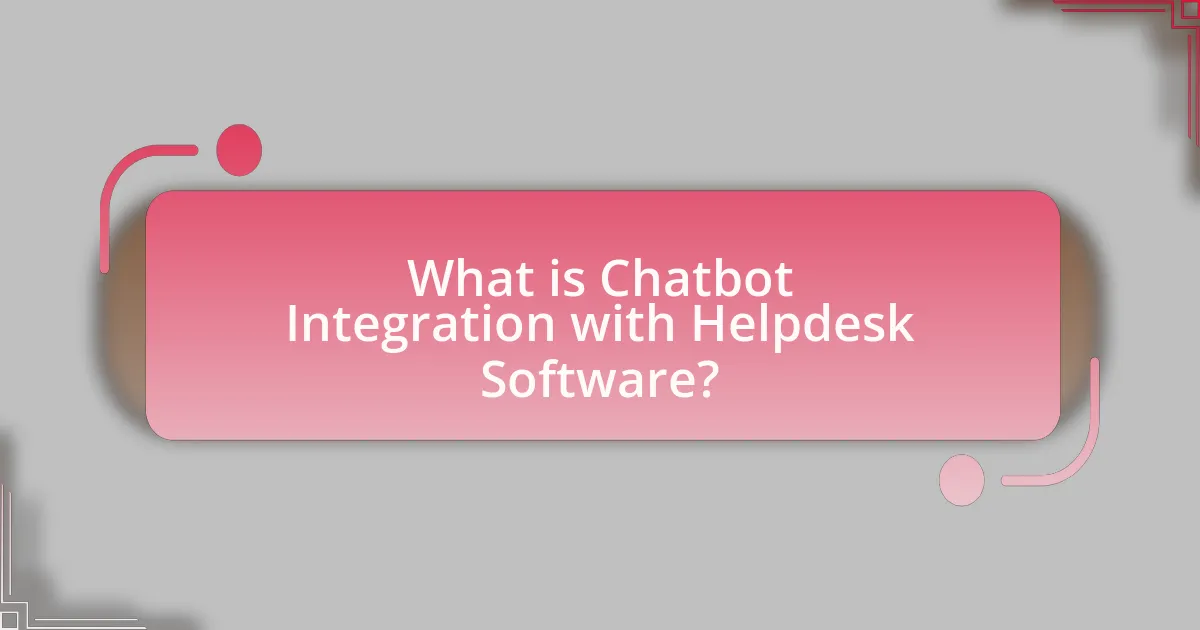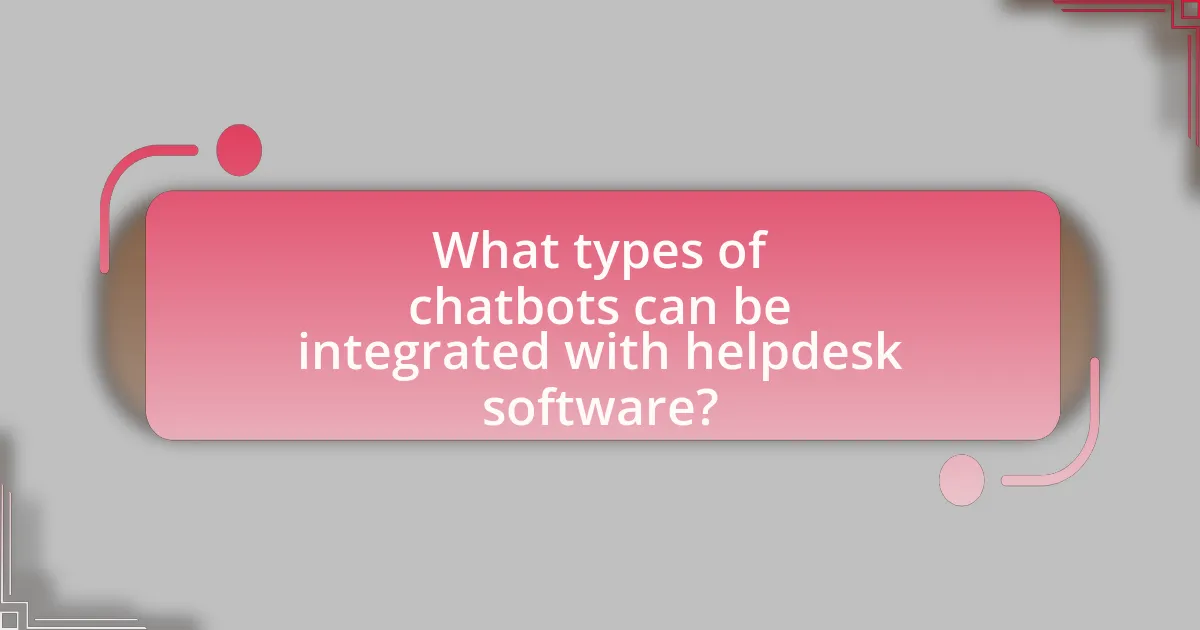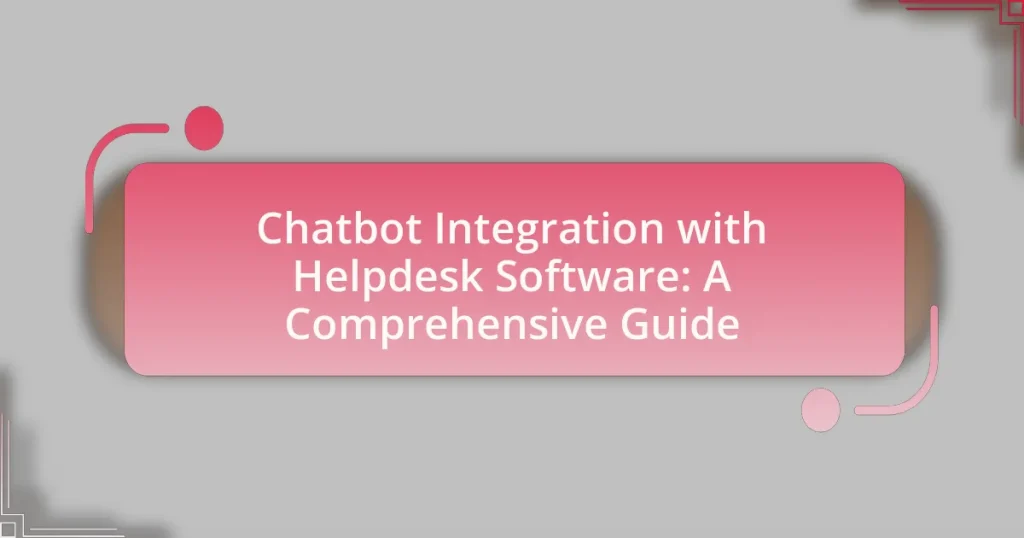Chatbot integration with helpdesk software involves incorporating automated conversational agents into customer support systems to improve service efficiency and enhance user experience. This integration automates responses to common inquiries, allowing human agents to focus on complex issues, thus reducing response times and increasing customer satisfaction. Key features include 24/7 availability, seamless ticket creation, and natural language processing capabilities. The article also explores the types of chatbots, their advantages, implementation steps, and best practices for successful integration, while addressing common challenges faced by helpdesks and metrics for evaluating integration success.

What is Chatbot Integration with Helpdesk Software?
Chatbot integration with helpdesk software refers to the process of incorporating automated conversational agents into customer support systems to enhance service efficiency and user experience. This integration allows chatbots to handle common inquiries, provide instant responses, and assist human agents by managing routine tasks, thereby reducing response times and improving customer satisfaction. According to a report by Gartner, by 2025, 75% of customer service interactions will be powered by AI, highlighting the growing trend and effectiveness of such integrations in modern helpdesk solutions.
How does chatbot integration enhance helpdesk operations?
Chatbot integration enhances helpdesk operations by automating responses to common inquiries, thereby increasing efficiency and reducing response times. This automation allows human agents to focus on more complex issues, improving overall service quality. For instance, a study by IBM found that chatbots can handle up to 80% of routine queries, significantly decreasing the workload on helpdesk staff. Additionally, chatbots provide 24/7 support, ensuring that customers receive assistance outside of regular business hours, which can lead to higher customer satisfaction rates.
What are the key features of chatbot integration in helpdesk software?
The key features of chatbot integration in helpdesk software include automated responses, 24/7 availability, seamless ticket creation, and natural language processing capabilities. Automated responses allow chatbots to handle common inquiries instantly, reducing response times and improving customer satisfaction. The 24/7 availability ensures that users can receive assistance at any time, enhancing user experience. Seamless ticket creation enables chatbots to convert conversations into support tickets, streamlining the workflow for human agents. Natural language processing capabilities allow chatbots to understand and respond to user queries more effectively, improving interaction quality. These features collectively enhance operational efficiency and customer engagement in helpdesk environments.
How does chatbot integration streamline customer support processes?
Chatbot integration streamlines customer support processes by automating responses to common inquiries, thereby reducing the workload on human agents. This automation allows for 24/7 availability, enabling customers to receive immediate assistance without waiting for human intervention. According to a study by IBM, chatbots can handle up to 80% of routine questions, which significantly decreases response times and improves customer satisfaction. Additionally, chatbots can gather and analyze customer data, providing insights that help improve service quality and efficiency.
Why is chatbot integration important for modern helpdesk solutions?
Chatbot integration is important for modern helpdesk solutions because it enhances efficiency and improves customer satisfaction. By automating responses to common inquiries, chatbots reduce the workload on human agents, allowing them to focus on more complex issues. According to a report by Gartner, chatbots can handle up to 80% of routine customer interactions, which significantly decreases response times and operational costs. This integration also provides 24/7 support, ensuring that customers receive assistance at any time, further increasing overall service quality.
What challenges do helpdesks face that chatbots can address?
Helpdesks face challenges such as high ticket volumes, long response times, and limited availability of human agents, which chatbots can effectively address. Chatbots can handle multiple inquiries simultaneously, reducing wait times and improving customer satisfaction. According to a study by IBM, chatbots can resolve up to 80% of routine inquiries, allowing human agents to focus on more complex issues. Additionally, chatbots provide 24/7 support, ensuring that customers receive assistance outside of regular business hours, which enhances overall service efficiency.
How does chatbot integration improve response times and customer satisfaction?
Chatbot integration significantly improves response times and customer satisfaction by automating interactions and providing instant support. Chatbots can handle multiple inquiries simultaneously, reducing wait times for customers and ensuring that they receive immediate assistance, which is crucial in enhancing the overall customer experience. According to a study by IBM, businesses can save up to 30% in customer service costs by implementing chatbots, as they can resolve issues without human intervention. This efficiency not only speeds up response times but also allows human agents to focus on more complex queries, further improving service quality and customer satisfaction.

What types of chatbots can be integrated with helpdesk software?
There are primarily three types of chatbots that can be integrated with helpdesk software: rule-based chatbots, AI-driven chatbots, and hybrid chatbots. Rule-based chatbots operate on predefined scripts and can handle specific queries, making them suitable for straightforward customer interactions. AI-driven chatbots utilize natural language processing and machine learning to understand and respond to a wider range of inquiries, providing more personalized support. Hybrid chatbots combine both rule-based and AI capabilities, allowing for flexibility in handling various customer service scenarios. These integrations enhance efficiency and improve customer satisfaction by streamlining communication and support processes.
What are the differences between rule-based and AI-driven chatbots?
Rule-based chatbots operate on predefined rules and scripts, responding to specific keywords or phrases, while AI-driven chatbots utilize natural language processing and machine learning to understand and generate responses based on context. Rule-based chatbots are limited in their ability to handle complex queries and can only provide answers that fit their programmed scenarios, whereas AI-driven chatbots can learn from interactions, adapt to user behavior, and handle a wider range of inquiries. For example, a study by Gartner indicates that by 2025, 75% of customer service interactions will be powered by AI, highlighting the growing preference for AI-driven solutions over traditional rule-based systems.
How do rule-based chatbots function in helpdesk scenarios?
Rule-based chatbots function in helpdesk scenarios by following predefined rules and scripts to provide automated responses to user inquiries. These chatbots utilize decision trees and keyword recognition to interpret user inputs and deliver relevant information or solutions based on specific triggers. For example, if a user asks about password recovery, the chatbot recognizes keywords related to that topic and responds with the appropriate steps to reset a password. This method ensures consistent and accurate responses, as the chatbot operates within the confines of its programmed rules, which are often based on common customer queries and issues.
What advantages do AI-driven chatbots offer for customer interactions?
AI-driven chatbots enhance customer interactions by providing instant responses and 24/7 availability. This immediacy improves customer satisfaction, as studies show that 64% of consumers expect real-time assistance regardless of the time of day. Additionally, AI chatbots can handle multiple inquiries simultaneously, significantly reducing wait times and increasing efficiency. According to a report by Juniper Research, businesses can save up to $8 billion annually by implementing chatbots for customer service tasks. Furthermore, AI chatbots utilize natural language processing to understand and respond to customer queries accurately, leading to a more personalized experience. This capability not only streamlines communication but also fosters customer loyalty, as 70% of consumers report a preference for interacting with chatbots for quick queries.
What are the most popular chatbot platforms for helpdesk integration?
The most popular chatbot platforms for helpdesk integration include Zendesk, Freshdesk, Intercom, and Drift. Zendesk offers a robust API and pre-built integrations, making it a top choice for businesses seeking seamless customer support solutions. Freshdesk provides AI-driven chatbots that enhance ticketing systems, allowing for efficient query resolution. Intercom is known for its user-friendly interface and proactive messaging capabilities, which improve customer engagement. Drift focuses on real-time communication and lead generation, making it ideal for sales-oriented helpdesk functions. These platforms are widely recognized for their effectiveness in enhancing customer service through automation and integration with existing helpdesk systems.
Which platforms provide the best features for helpdesk integration?
Zendesk, Freshdesk, and ServiceNow provide the best features for helpdesk integration. Zendesk offers robust ticketing systems, multi-channel support, and extensive API capabilities, making it ideal for seamless integration with various platforms. Freshdesk features automation tools, a user-friendly interface, and integrations with popular applications, enhancing customer support efficiency. ServiceNow stands out with its IT service management capabilities, offering advanced workflows and integration options that cater to enterprise-level needs. These platforms are widely recognized for their comprehensive features and user satisfaction in helpdesk integration.
How do different platforms compare in terms of ease of use and functionality?
Different platforms for chatbot integration with helpdesk software vary significantly in ease of use and functionality. For instance, platforms like Zendesk and Freshdesk offer user-friendly interfaces that simplify setup and management, allowing users to create and deploy chatbots with minimal technical expertise. In contrast, platforms such as Microsoft Bot Framework require more technical knowledge, making them less accessible for non-developers.
Functionality also differs; Zendesk provides robust analytics and reporting features, enhancing user experience through data-driven insights, while platforms like Intercom focus on personalized customer interactions but may lack advanced reporting capabilities. According to a survey by Software Advice, 70% of users prioritize ease of use when selecting helpdesk software, indicating that user-friendly platforms tend to be favored in the market.

How can businesses implement chatbot integration with helpdesk software?
Businesses can implement chatbot integration with helpdesk software by selecting a compatible chatbot platform, configuring it to handle common customer inquiries, and connecting it to the helpdesk system via APIs. This integration allows chatbots to access ticketing systems, enabling them to create, update, and resolve tickets automatically. For instance, according to a report by Gartner, organizations that utilize chatbots for customer service can reduce operational costs by up to 30%. By leveraging this technology, businesses can enhance response times and improve customer satisfaction.
What steps are involved in integrating a chatbot with helpdesk software?
Integrating a chatbot with helpdesk software involves several key steps. First, select a compatible chatbot platform that supports integration with your specific helpdesk software. Next, configure the chatbot settings to align with your helpdesk’s workflows, including defining intents and responses relevant to customer inquiries. After configuration, utilize APIs or integration tools provided by both the chatbot and helpdesk software to establish a connection, ensuring data flow between the two systems. Finally, test the integration thoroughly to confirm that the chatbot can effectively handle queries and escalate issues to human agents when necessary. This process is validated by the fact that successful integrations enhance customer support efficiency and improve response times.
How do businesses assess their needs before integration?
Businesses assess their needs before integration by conducting a thorough analysis of their current processes, identifying gaps, and determining specific objectives for the integration. This involves evaluating existing workflows, customer interactions, and support ticket management to pinpoint inefficiencies or areas for improvement. For instance, a study by McKinsey found that companies that clearly define their integration goals are 30% more likely to achieve successful outcomes. By aligning the integration with strategic business objectives, such as enhancing customer satisfaction or reducing response times, businesses can ensure that the integration of chatbot technology with helpdesk software meets their operational requirements effectively.
What are the technical requirements for successful integration?
Successful integration of chatbots with helpdesk software requires a robust API (Application Programming Interface) that facilitates seamless communication between the two systems. This API must support standard protocols such as REST or SOAP to ensure compatibility and ease of use. Additionally, the integration should include secure authentication methods, such as OAuth, to protect sensitive data during interactions.
Furthermore, the helpdesk software must have the capability to handle real-time data exchange, enabling the chatbot to access and update ticket information promptly. A reliable data format, typically JSON or XML, is essential for structured data transfer.
Lastly, comprehensive documentation and support from both the chatbot and helpdesk software providers are crucial for troubleshooting and optimizing the integration process. These technical requirements ensure that the integration functions smoothly and enhances overall user experience.
What best practices should be followed during the integration process?
During the integration process of chatbots with helpdesk software, best practices include thorough planning, clear communication, and iterative testing. Thorough planning ensures that all stakeholders understand the objectives and requirements, which facilitates smoother execution. Clear communication among team members and between the chatbot and helpdesk systems is essential for effective data exchange and user experience. Iterative testing allows for the identification and resolution of issues in real-time, ensuring that the integration meets user needs and functions correctly. These practices are supported by industry standards that emphasize the importance of structured approaches in software integration, leading to higher success rates and user satisfaction.
How can businesses ensure a smooth transition to chatbot integration?
Businesses can ensure a smooth transition to chatbot integration by conducting thorough planning and testing before deployment. This involves defining clear objectives for the chatbot, selecting the right technology that aligns with existing helpdesk software, and training staff on how to interact with the chatbot effectively. Additionally, implementing a phased rollout allows for gradual adjustments based on user feedback, which can enhance the chatbot’s performance and user satisfaction. Research indicates that companies that invest in comprehensive training and iterative testing experience a 30% increase in user engagement with chatbots, demonstrating the importance of these strategies in achieving successful integration.
What common pitfalls should be avoided during implementation?
Common pitfalls to avoid during chatbot integration with helpdesk software include inadequate planning, lack of user training, and insufficient testing. Inadequate planning can lead to misalignment between the chatbot’s capabilities and user expectations, resulting in poor user experience. Lack of user training can hinder staff from effectively utilizing the chatbot, reducing its potential benefits. Insufficient testing may result in unresolved bugs or functionality issues, which can negatively impact customer interactions. Research indicates that 70% of chatbot implementations fail due to these common pitfalls, highlighting the importance of thorough preparation and execution.
What are the key metrics to evaluate the success of chatbot integration?
The key metrics to evaluate the success of chatbot integration include user satisfaction, resolution rate, engagement rate, and response time. User satisfaction can be measured through post-interaction surveys, with studies indicating that a satisfaction score above 80% typically signifies effective chatbot performance. Resolution rate reflects the percentage of inquiries successfully handled by the chatbot without human intervention; a high resolution rate, often above 70%, indicates strong integration. Engagement rate, which tracks user interactions with the chatbot, helps assess its effectiveness in maintaining user interest; a rate exceeding 50% is generally considered successful. Finally, response time measures how quickly the chatbot replies to user queries, with optimal response times being under 5 seconds to ensure a positive user experience.
How can businesses measure customer satisfaction post-integration?
Businesses can measure customer satisfaction post-integration by utilizing surveys, Net Promoter Score (NPS), and customer feedback analysis. Surveys can be distributed immediately after customer interactions with the chatbot, allowing businesses to gather direct feedback on user experience and satisfaction levels. NPS provides a quantifiable metric by asking customers how likely they are to recommend the service, which can indicate overall satisfaction. Additionally, analyzing customer feedback through sentiment analysis tools can help identify trends and areas for improvement, ensuring that the integration meets customer needs effectively. These methods are supported by industry practices that emphasize the importance of continuous feedback loops in enhancing customer experience.
What performance indicators should be tracked for continuous improvement?
Key performance indicators (KPIs) that should be tracked for continuous improvement in chatbot integration with helpdesk software include customer satisfaction score (CSAT), first response time, resolution time, and user engagement metrics. Tracking CSAT provides insights into user satisfaction, while monitoring first response and resolution times helps identify efficiency in handling inquiries. User engagement metrics, such as the number of interactions per session, indicate how effectively the chatbot is serving users. These indicators collectively enable organizations to assess performance and implement targeted improvements, ultimately enhancing the overall user experience.
What troubleshooting tips can help optimize chatbot performance in helpdesk software?
To optimize chatbot performance in helpdesk software, regularly monitor and analyze user interactions to identify common issues and areas for improvement. This involves reviewing conversation logs to detect patterns in user queries that the chatbot struggles to address effectively. Additionally, updating the chatbot’s knowledge base with frequently asked questions and ensuring it has access to the latest information can enhance its responsiveness. Implementing machine learning algorithms can also help the chatbot learn from past interactions, improving its accuracy over time. Regularly testing the chatbot’s functionality and user experience through simulated conversations can further identify technical glitches or misunderstandings, allowing for timely adjustments.










